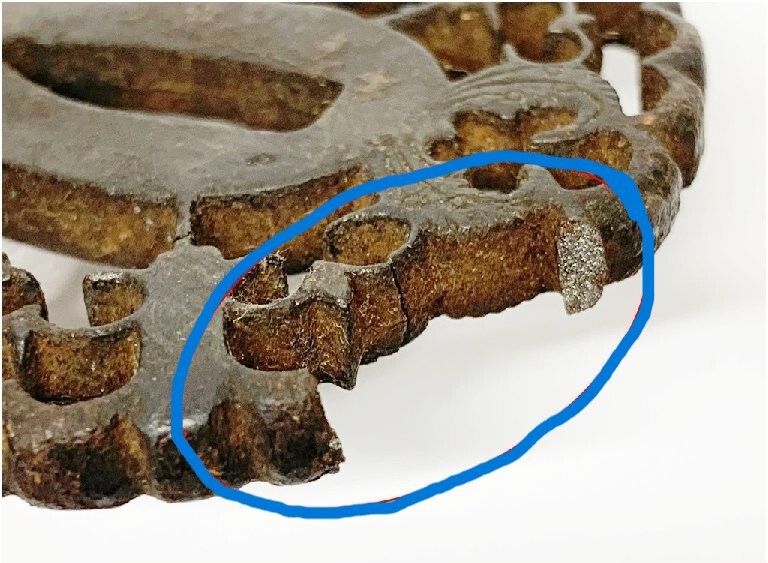
Dan tsuba
Gold Tier-
Posts
761 -
Joined
Everything posted by Dan tsuba
-
Hello all! I know this post is somewhat “off the thread” but I wanted to respond to Mark- Mark, thank you, sensei. Of course, you are correct in the amount of training required to achieve “muscle memory” and a “non-thinking” response. To have to “think” of doing a move before doing it can waste milliseconds and result in defeat. I have been fortunate to have competed in International and National (both types of tournaments in the United States) competitions in karate. Personally, I think I have forgotten more karate than most people have been taught! I was 63 at my last National competition, and now only train (at 72 – probably never will compete again, but then again “never say never”!). Hey, too much “feeling the pain” nowadays! I have been taught many things in my 37 years of training (yes, I started training when I was 35 – what was I thinking!). But now after all the hundreds of techniques I have been taught I keep training in only a couple of them. Maybe only 3 types of blocks, 3 punches, and 2 kicks. But those have been done “with no thought” for many years. I fully agree with you, and I feel that “strategy” is much more important than any kind of “secret” technique. An opponent can throw his “secret” technique. But with maintaining proper distance and “watchfulness” any “secret” technique can be neutralized. Again, just my opinion. With respect, Dan
-
Hello all! Thomas, thanks for the invite to show me the “other type” of sword draws! Unfortunately, I don’t think that is a possibility. I noticed your post on this thread about the patination on a tsuba. Maybe you made an error? My thoughts are perhaps that should be a “new thread” in itself? Also, I was not laughing at you. If you thought that then I do apologize. I was just “surprised” on the “700” number that you came up with. I am also aware that there were many “secret” type of techniques that were taught and passed along orally to students. Probably, many of those “secrets” were “lost over the years”. But since you brought up the subject of “secret" techniques, I have found a few quotes from “The Art of Peace” by Morihei Ueshiba- Ninety-Four- Progress comes To those who Train and train, Reliance on secret techniques Will get you nowhere. Ninety-Five- Fiddling with this And that technique Is of no avail. Simply act decisively Without reserve! One Hundred Two – Ultimately, you must forget about technique. The further you progress, the fewer teachings there are. The Great Path is really No Path. Some interesting stuff! With respect, Dan
-
Hello all! Wow Bob, great “outside of the box” thinking. I couldn’t see that “sounding bell” before. And now, since your post, I can’t unsee it! Well done! Again, just my opinion. With respect, Dan
-
Hello all! You’ve got to be kidding me! 700 different ways to “draw the sword” (do the “simplest of actions”- as stated in a previous post to this thread)! Hey, it is a sword in a saya. Probably only about 2 ways to “draw it” from the saya. Remember, we are talking about Japan where most all things (including the “basics” of martial arts) are probably done in a very “specific” and standardized manner. You know, not all tsuba were made for combat. I have read where many samurai had 3 or 4 tsuba for each of their daisho. Maybe a “combat” tsuba. A tsuba for “everyday carry”. A tsuba for royal and court functions. And maybe a tsuba to reflect their “clan”. It is my understanding that in a “court” or “royal” setting the drawing of a sword could result in the “beheading” of the person that drew the sword. What better way to keep something like that from happening then to mount a tsuba on a sword that would make it “difficult” or “challenging” to draw the sword from the saya?? It would show the “nobles” that this samurai is only carrying his daisho for “show” and respect (as I have read that all samurai had to “by law” carry daisho). And it would give the samurai an opportunity to “show off” his most delicate and beautiful tsuba. A previous post stated “hit the nail on the head”. I think the nail was missed entirely! Hey, but these are just my opinions (and everyone has their own opinions)! With respect, Dan
-
Hello all, So, when I perform Nukitsuke the knuckle of my left thumb is over the mimi of the tsuba to “lock” the sword in the saya. My right hand is on the tsuka. Then as I move forward my thumb moves from the mimi of the tsuba to the ura (hira) of the tsuba (below the mimi) and pushes against it to “unlock” the sword from the saya. If I make an error in my movements before the sword is drawn, I just use my right hand on the tsuka to move the sword back into the saya. I do not put my thumb back over the mimi of the tsuba to move the sword back into the saya. I don’t know, maybe I have been performing nukitsuke wrong all these years. Hey, that is always a possibility! My iaido sensei (a “long” time ago) was from Japan and wore a “old” daisho of “live blades” (shinken). I just think that some tsuba are more conducive to be used for nukitsuke than other tsuba (if the thumb is used). Of course, I do not know how samurai were trained on “the draw”. Perhaps some used their thumb to “unlock” the sword and others just used their hand on the tsuka to draw the sword out of the saya (no thumb needed!). Personally, I could not see using the tsuba (shown below – there are many more pictures of this type of tsuba “out there”) for performing “my type” of nukitsuke. Anyway, just some more interesting stuff in this fantastic “world of tsuba! With respect, Dan
-
Hello all! Just something interesting. In Iaido (the drawing of the sword-Nukitsuke) we are taught to draw the sword (Iaito) by placing our left hand around the top of the saya and our thumb against the “ura” of the tsuba. The right hand is placed around the tsuka. Then you push the tsuba with your thumb to “unlock” the habaki from the saya. So, the sword is now ready to be “drawn” from the saya. Now, there are some very nice tsuba out there that are very delicately made. However, would (or even could) these tsuba be used to actually draw the sword from the saya? Several beautiful tsuba seem to have large open “spaces” at the top of the tsuba that would be very difficult to place one’s thumb against to perform “Nukitsuke”. Personally, I have never used an open type tsuba in Iaido. Are there any Iaido practitioners out there that prefer to use this kind of tsuba. Is it more difficult to use this kind of tsuba? Would it be practical in the the Muromachi and Edo periods and used on a sword, or would it just be placed on the sword for “display” purposes? Anyway, have included a couple of pictures of “open type” tsuba that I could find just for explanatory purposes. With respect, Dan
-
Hey Geoffrey, All sorts of great information being posted on this thread about your “thrift store” finds! I don’t know, perhaps you already have been sent emails by “dealers”. Maybe they are willing to assist in determining the status of your tsuba. I just wanted to throw in my 2 cents worth of information (maybe only 1 cent worth!). There are organizations (NBTHK and NTHK - you can find out about these on this forum or check out the internet) that you can send your tsuba to, and for a fee they can “authenticate” your tsuba and send you “certification” papers (if your tsuba are the “real deal”- hey they look good to me-but then I really don’t know much about tsuba and am easily “taken in”!). Once (and if) certification papers are issued, they can easily double the price of your tsuba. So, if you ever are serious about selling them this may be an option. However, I have heard that this can be an expensive process. If I was lucky enough to own tsuba like yours, I would just put a nail in the wall and hang them up by the nakago-ana (the long tang hole in the center) and enjoy them like I do with all of my tsuba (I only have about 120 of them and the collection is “still growing”! I need more wall space!). The main enjoyment for me is the artwork, craftsmanship, skill, possible age and history, and the possible story that the tsuba can sometimes “tell” in its motif. Like I said in my previous post to this thread “I don’t have any tsuba as nice as yours”!! With respect, Dan
-
Hello all! Geoffery, welcome to the forum! Man, what a fantastic find! I am super jealous! I have been collecting for about only 4 years, but don’t have any tsuba as nice as yours. My opinion (and advice) is not to sell them. Just enjoy them for a while. The value of your tsuba is only going to increase over time. The “Edo period “(and other Japanese period) tsuba are dwindling in numbers as they are “bought up” by collectors. Research them and find out as much as you can about them (you can find research material to study on this forum). They are full of history and the motifs on some of them are based on Japanese legends and have “amazing stories” to tell. Study the signatures (called Mei) on some of the tsuba (if you need assistance there is a “translation” section on this forum). Those signatures can give you insight into the “age” of the tsuba. Keep them, they are “treasures”! With respect, Dan
-
Hello all!! Ford, thank you so much for your post and opinions. Also, thanks for the references that you have included. I will try to purchase one or two and “learn many new things”. Hurrah!! I have been advised (from a previous post on this thread) to give any opinion of yours “careful thought”. But as a part of “academia” I must disagree with you on the fact that corrosion and rust can be used interchangeably. The tsuba in the thread is rusted because it is iron. Further, it is rusted and has therefore corroded. If it was not made from iron and had deteriorated, it would be corroded and not rusted. Like I stated in a previous post, a minor point. But with the previous advice, this point has taken on “new meaning”! I refer those interested to these few links. There are many other supporting “links” out there. https://dewwool.com/difference-between-rusting-and-corrosion/ https://www.arepa.com/resources/blog/corrosion-vs-rust-what-s-the-difference/#:~:text=Corrosion%20is%20the%20process%20by,of%20iron%20and%20its%20alloys. https://byjus.com/chemistry/difference-between-rust-and-corrosion/ With respect, Dan
-
Hello all!! So, some have stated that this tsuba is “corroded”. It is my understanding that corrosion appears as blue or green, depending on the metal. “Rust” appears only on iron objects and appears as reddish or brown. “Corrosion and rust are often used interchangeably. While corrosion and rust are both a result of oxidation reactions (where an element combines with oxygen), there are differences between the two. Corrosion impacts a wide range of objects, while rust only impacts iron and its alloys, such as steel. Therefore, rust is a form of corrosion, although it specifically refers to oxidation of metals containing iron.” So, I believe the term “rust” (over the term “corrosion”) should be applied to this tsuba. Perhaps a “minor” point. But definitions are important to correctly describe an object or its “deterioration”. I am also of the opinion that this piece is an “older” piece (not a “modern-ish hobby piece worked up to look older than it really is” – as stated in the previous post). It is my opinion that the “rust” shown on this particular piece is authentic and would take a very long time to produce the “pitting” shown on this tsuba. With respect, Dan
-
Hello Daniel, nice meeting you on the forum- I noticed that your post has not been replied to. So, I have tried my best to figure something out. I hardly know anything about Japanese legends. But I recently bought a book titled “Legend in Japanese Art” by Henri L. Joly. So, after checking every picture in the book I found one that depicts what appears to be an old man and old woman. It is the Japanese fairly tale of “Momotaro”. It is evidently very well known in Japan, and it revolves around a young man (their son). Now on the pictures you posted I see what appears to be an old woman and an old man on one piece, and a younger man on the other piece (although there are some details on the pictures that are difficult to make out). Could this be part of the “Momotaro” fairy tale?? I don’t know, just thought maybe it is a possibility. With respect, Dan
-
Hello all! Here is an interesting tsuba that I saw. I have not seen anything like this previously. A “bell” shaped tsuba with a “hole” at the top of the bell and a “mask” at the bottom right. Was it used as a necklace after it was no longer used on a blade? It looks quite old and appears to have been mounted. It also appears to be a cast tsuba (or cast and hand worked?). Only the omote has a design and the ura is “hollow” with no design. A “strange” looking tsuba. Raises questions like “who would use it”, “was it fitted just for display only (or intended for use)”, “how old is it”, “why only a motif on one side”, “is it a Namban type”, “are there any others out there”, and other questions. Just an interesting piece (to me). Thought I would post it for opinions and thoughts. With respect, Dan
-
Hello all! Thanks, Glen, for posting the Shachi dragon fish tsuba side by side. So, is my Shachi fish dragon tsuba cast or not?? Has it been cast and worked by hand? I don’t believe it is cast. The “tagane-ato” probably could not be hammered into a cast tsuba (they would have to be molded with the tsuba). Also, probably (to me) what appears to be casting marks in the hitsu ana is more than likely a buildup of rust. Evidently, I dd not clean it very well!! Anyway, that particular tsuba is at my “main tsuba museum house” in Arizona. I am currently at my “annex tsuba museum house” in Wyoming. When I return to Arizona, I will check out that Shachi dragon fish tusba more closely to determine if it is possibly cast or not (or cast and worked by hand). With respect, Dan
-
Hello all, again! Thanks Glen for your analysis of that dragon tsuba. I can see what you are saying. Although I think I have another unique Shachi fish dragon tsuba. Dale has seen this one before. What is neat is that both hitsu ana are an "unusual" shape! The other similar Shachi fish tsuba on this thread don't look the same. With respect, Dan
-
Hello all!! So, here is another of my tsuba. Appears to have a couple of different carved "dragons". Shachi dragon fish on the left of the tsuba (with a pearl in its mouth?), a "normal" dragon at the top of the tsuba, and another "creature" (can't figure out what it is) on the lower right of the tsuba. With respect, Dan
-
Hello all, I believe this tsuba that I have has been altered. You can see where maybe a piece of the original tsuba was “cut” off of the kozuka hitsu ana. Most likely it was a “full wheel” type motif that may have become damaged at some point (in battle??) and was altered. With respect, Dan
-
Jean, Thank you so much for help with the translation. Maybe others will look at the post and better discern the crafstman, those are the best pictures I could get of the mei. Also, are you saying that this could be an Edo period cast tsuba? With respect, Dan
-
Hello all! So I am on vacation and bought this tsuba. I don't have my reference books with me. Can someone assist me with who the craftsman was and years active? Thank you. With respect, Dan
-
Hello David, I don’t know a lot about tsuba. But the motif on the tsuba you are asking about is interesting. I notice that on the back side of the tsuba is part of a Torii gate. A Torii gate is usually found at the entrance to a Shinto shrine. So maybe the figure on the front of the tsuba is a Shinto priest performing some sort of “cleaning” or “purification” ritual. Perhaps others on the forum can tell you more. With respect, Dan
-
Hello all! So, I recently purchased the below pictured tsuba. It has a carved dragon at the top, what appears to be a shachi dragon fish (on the left), and another design on the lower right of the tsuba (I don’t know what that represents). Both ura and omote side of the tsuba have the same carved motif. I personally find that somewhat rare in a tsuba. But what I find of major interest is that I believe two different artisans worked on this tsuba. The carving on the ura side is deep and appears well done. The carving on the omote side is shallower and is not as well done. There are also some differences to both carvings (flowers, dragon’s eyes, shachi dragon’s fish mouth, scales on the dragons, and other things). I was wondering if anyone has encountered this possibility of two different artisans working on one tsuba? Thoughts, opinions, and pictures would be greatly appreciated. With respect, Dan
-
Hello Bruno, What a fine pair of tsuba! I am envious! Anyway, I have a set of daisho swords (over 400 years old). Both tsuba on the set are exactly the same design, but the tsuba on the katana is larger than the tsuba on the wakizashi. With respect, Dan
-
Hello Marco, I don't know why anyone has not responded to your post? So, I just wanted to let you know my thoughts on the tsuba. Now, I know very little about tsuba. But the pictures you posted look to me like a very recent tsuba (or it could be an older tsuba that was well taken care of). Maybe someone else with way more knowledge than me can help you. Anyway, great to communicate with you for the first time! With respect, Dan
-
Hello again, JMB. I don't know that much about tsuba, but I am certain there are others that will read this thread and help you identify the school of maker. One thing I find interesting after looking closer at the pictures. It appears that the tsuba was mounted on at least two blades. I see a piece of copper at the top of the "nakago-ana" (the middle long slot where the tang of the blade would fit). Then I also see where there has been what appears to be a second layer (of lead?) added to the copper to re-fit it to another blade. I don't know if that is copper on the top and bottom of the tsuba that appears to be added to what were "holes" in the tsuba. Maybe a picture of the other side of the tsuba would help others to ascertain the characteristics of your tsuba. Anyway, just trying to help! With respect, Dan
-
Hello JMB, Welcome to the forum! I like your tsuba! It looks fairly old and seems to have been mounted before. I also have used Edo period tsuba to mount on two of my iaito swords. They work great, and it is neat to have a piece of history on my training swords! Good luck, With respect, Dan
-
So glad that my wife's idea may add a new aspect and way of displaying tsuba. That was a great idea of hers, but I will never tell her that!! Ha, ha, ha, etc. With respect, Dan





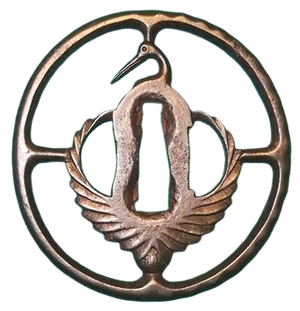
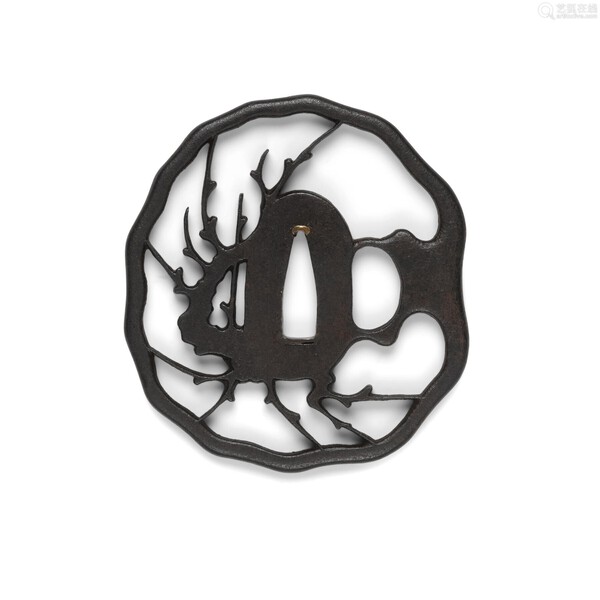
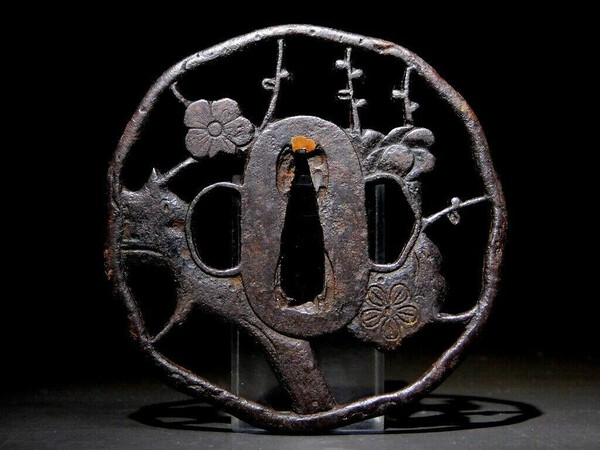
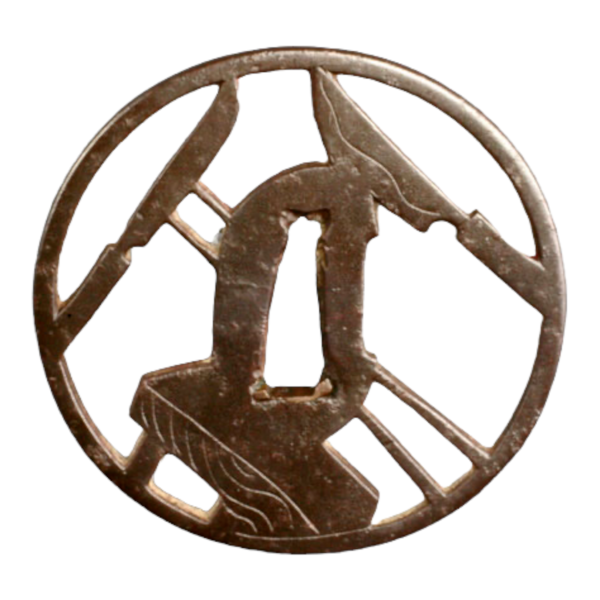
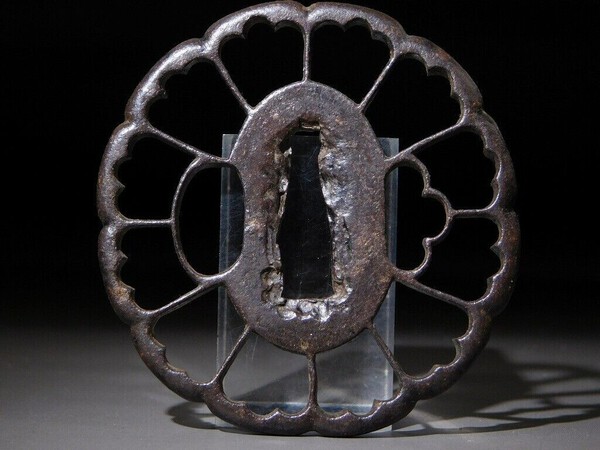


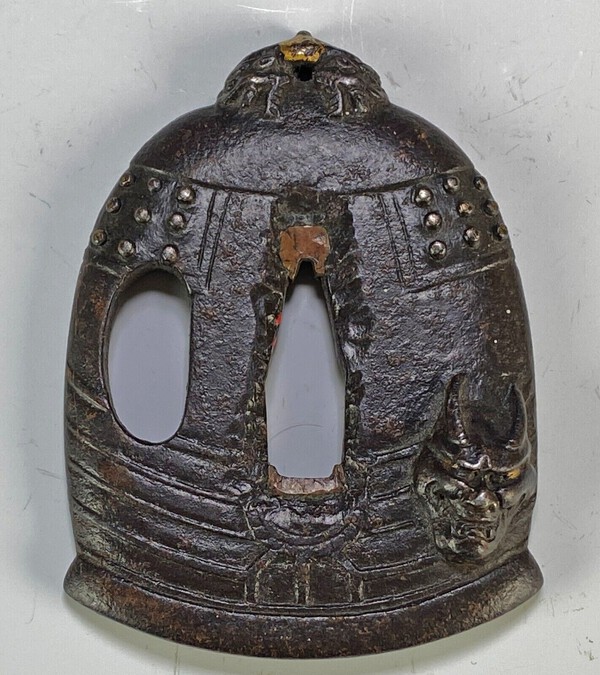
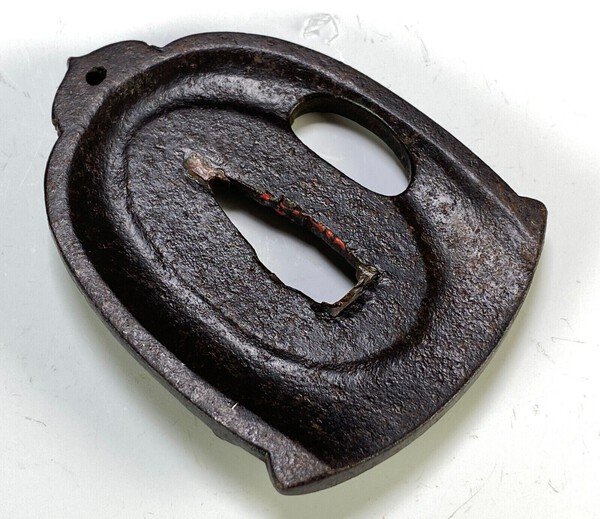

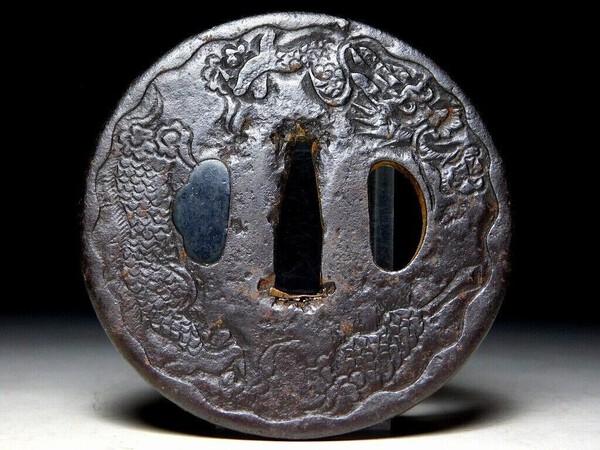
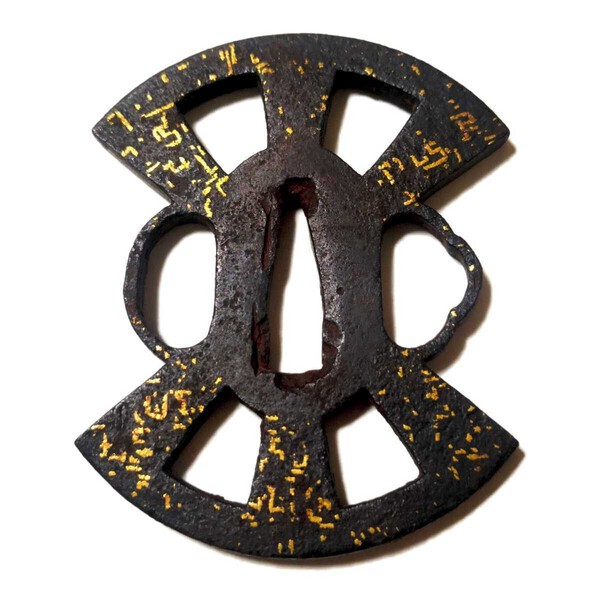
(1).thumb.jpg.fe75634a84db76d0eb2ffd1c66cdbf90.jpg)
(1).thumb.jpg.138e9b5c4698d21d65362f11c772edcd.jpg)